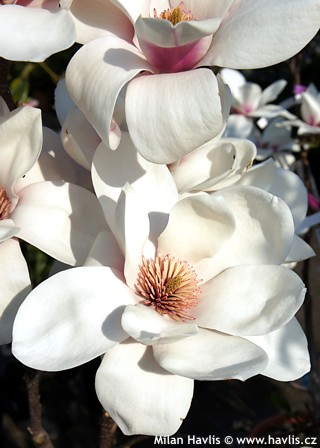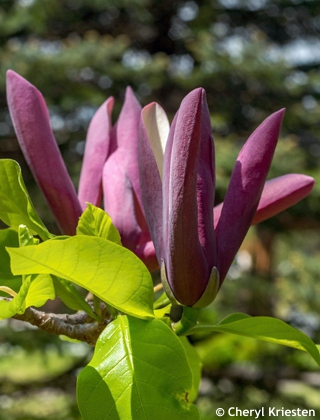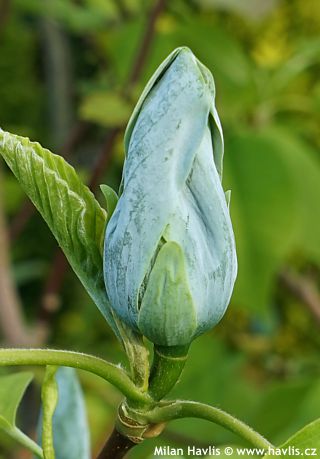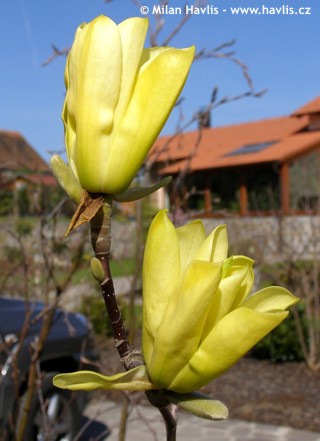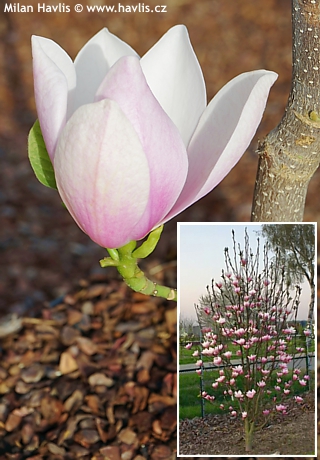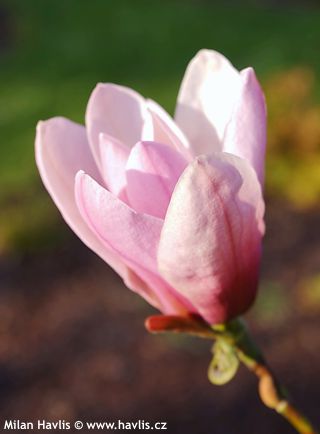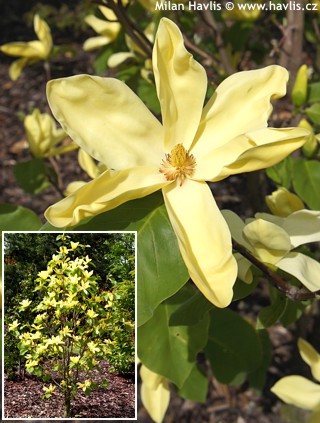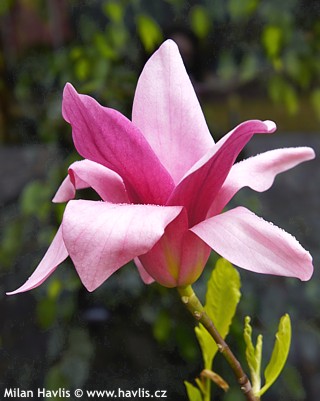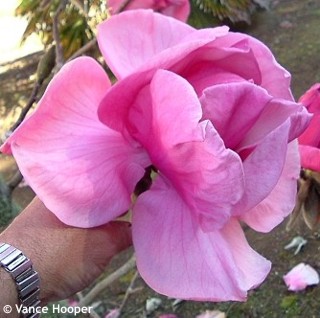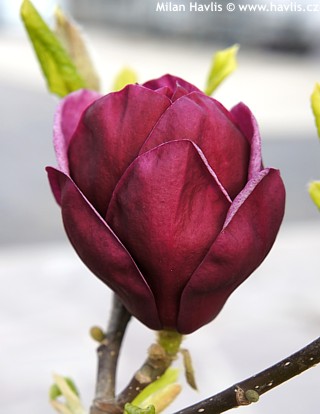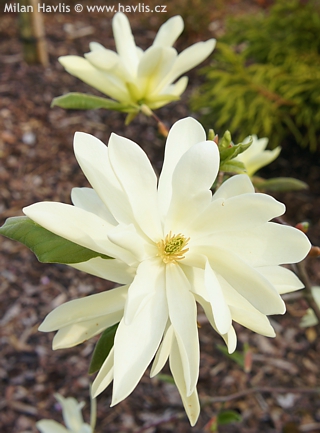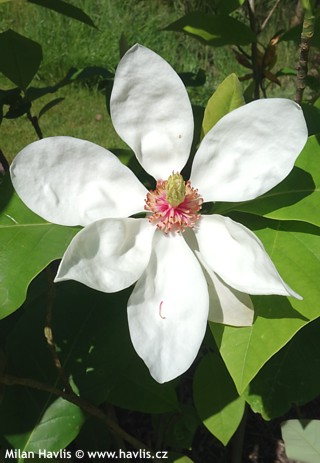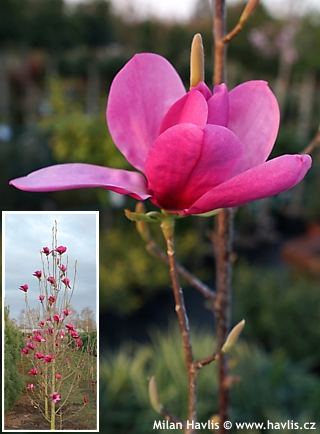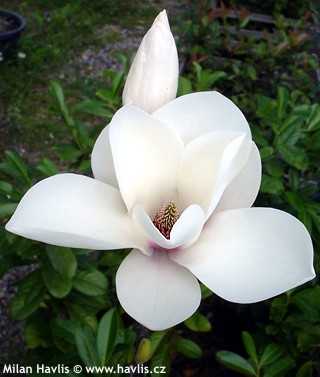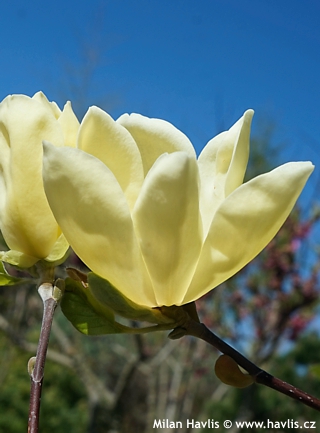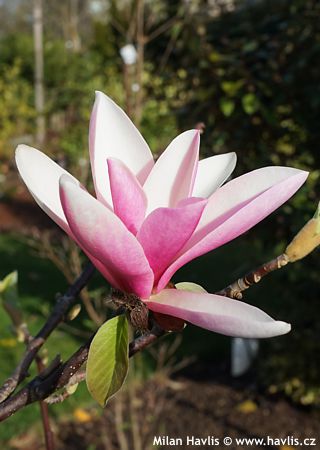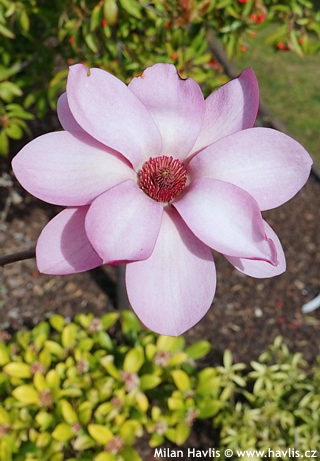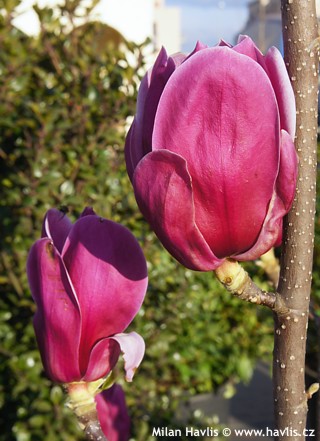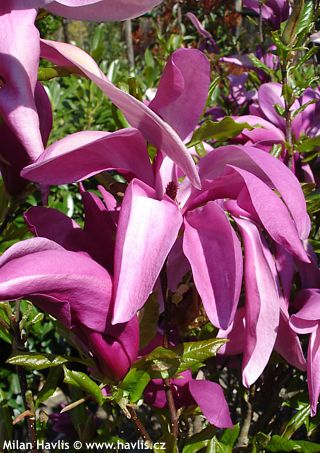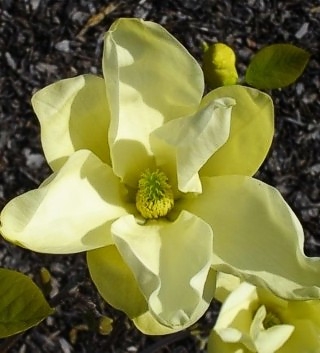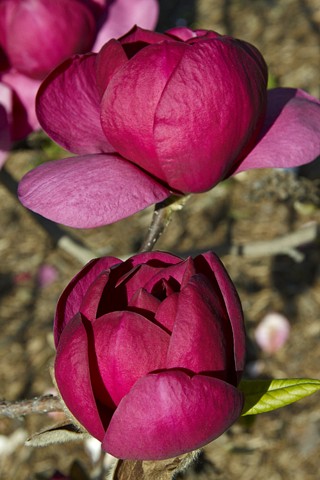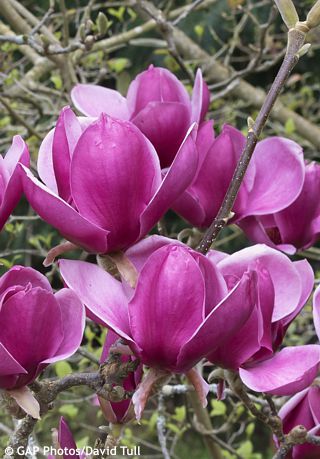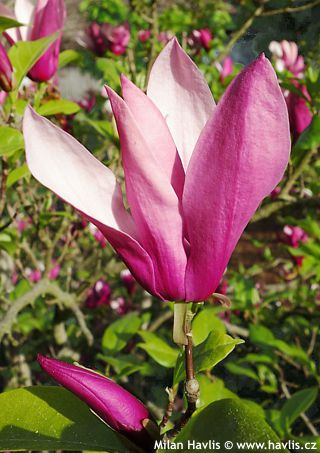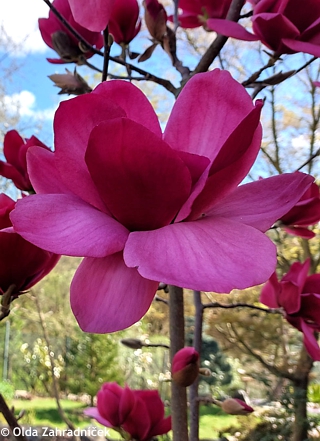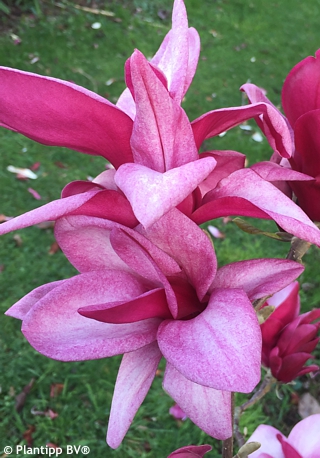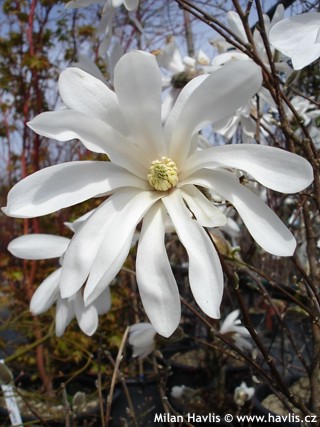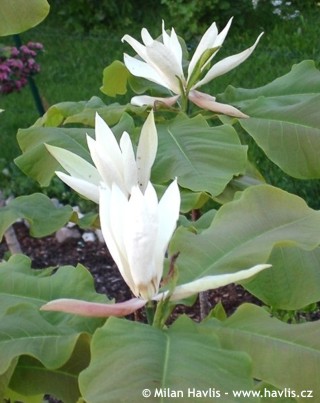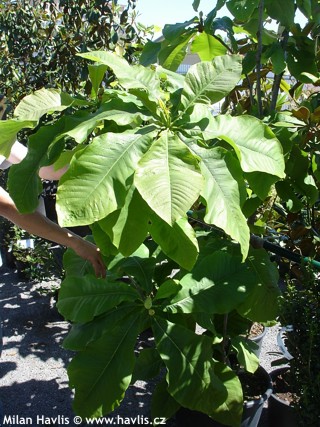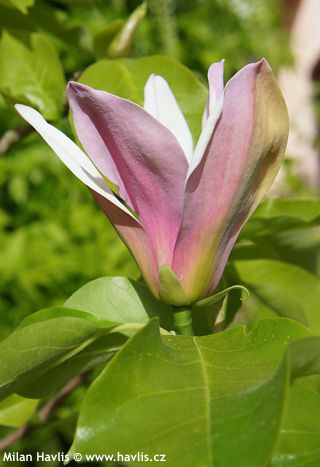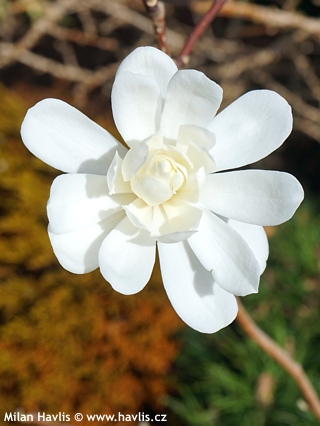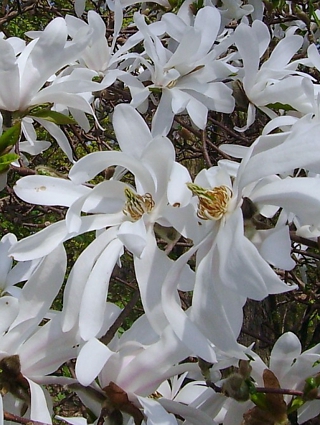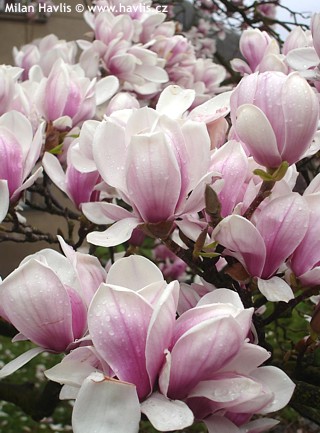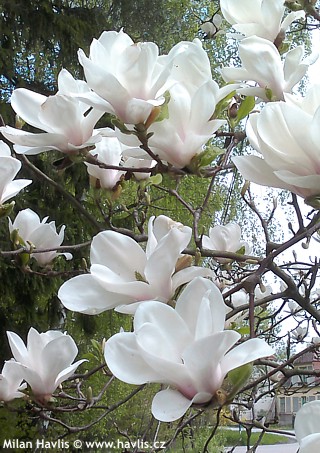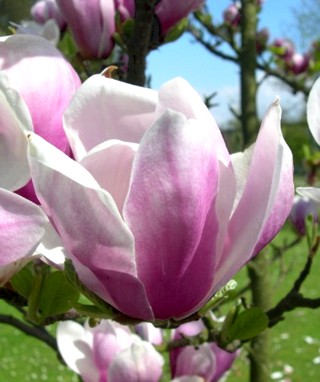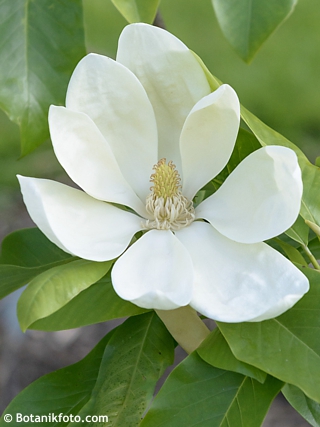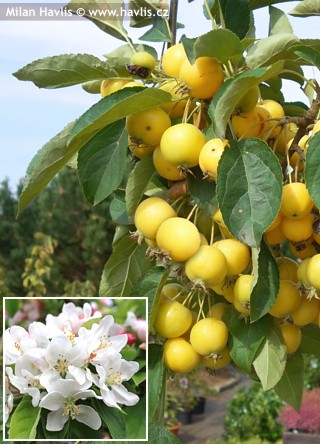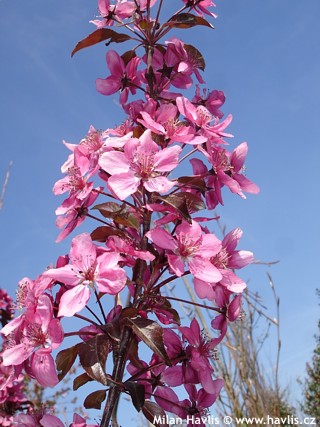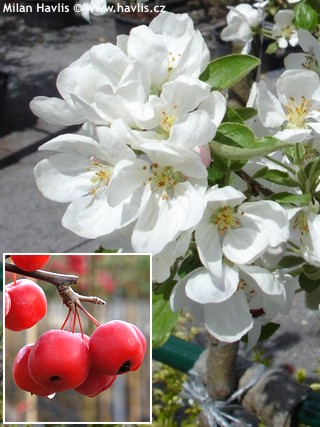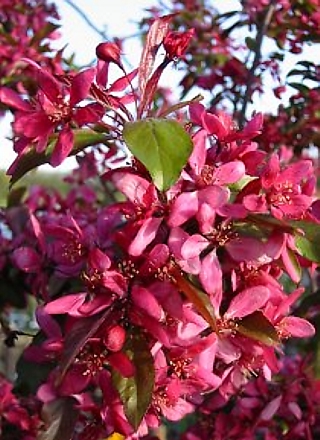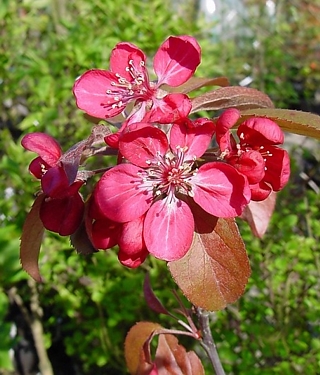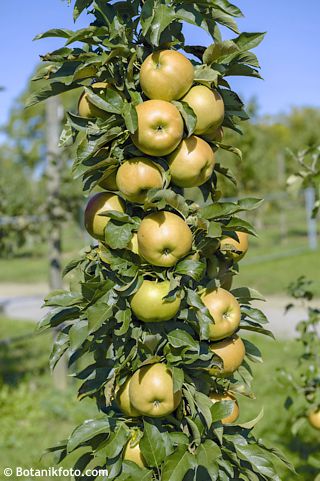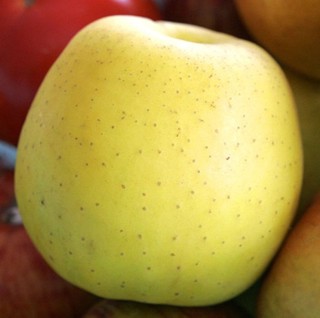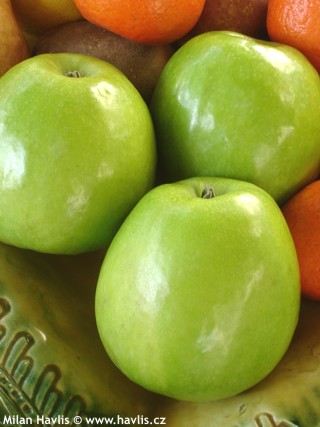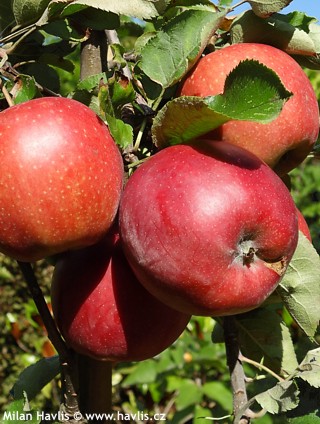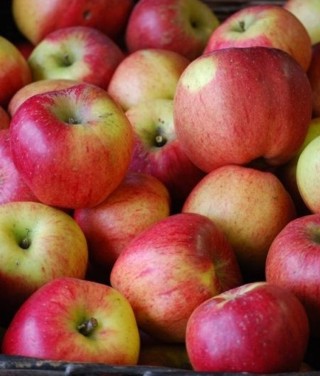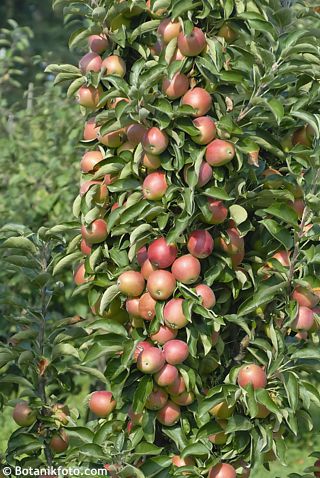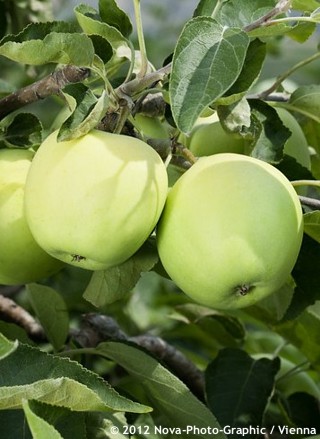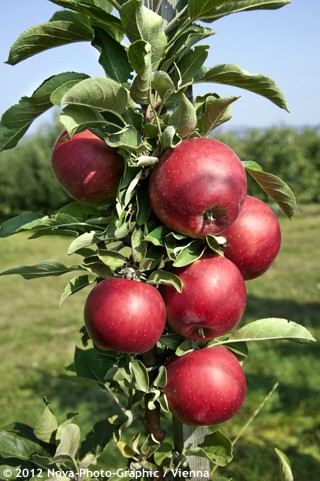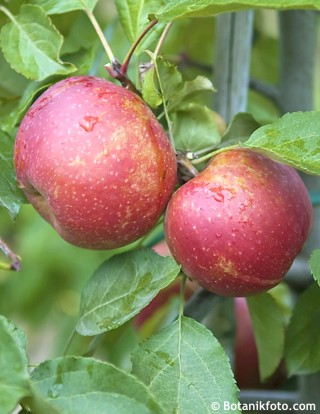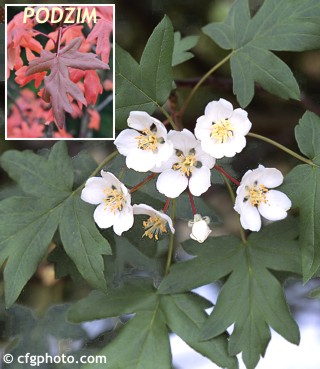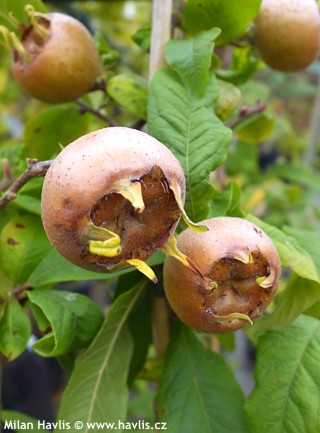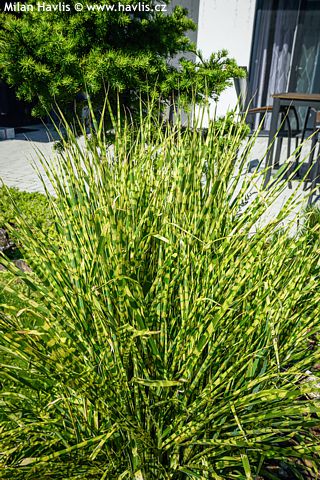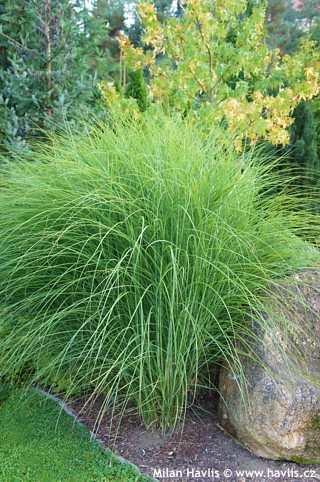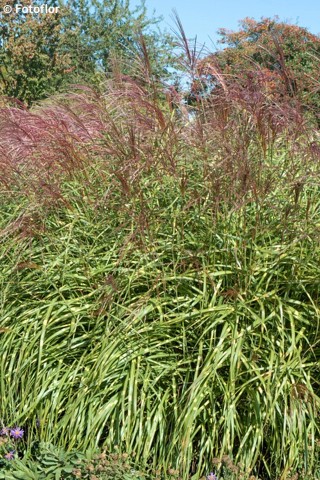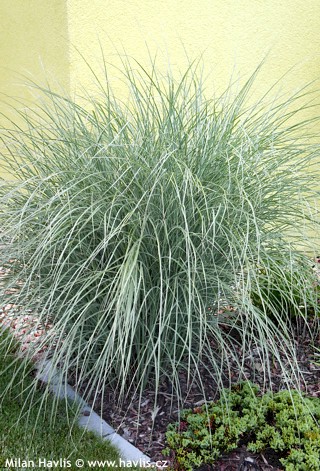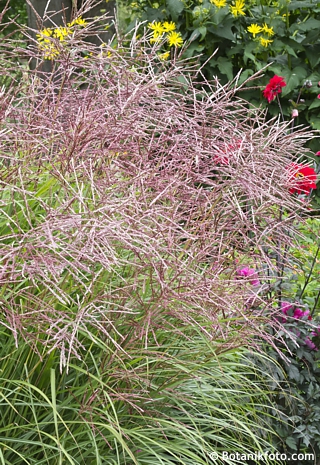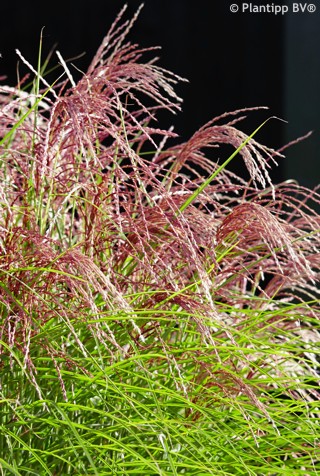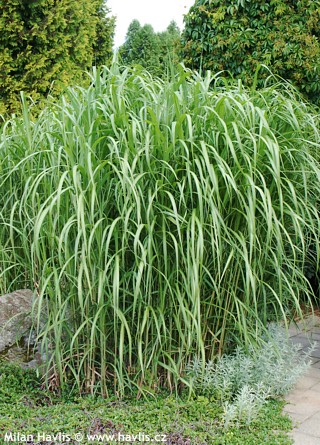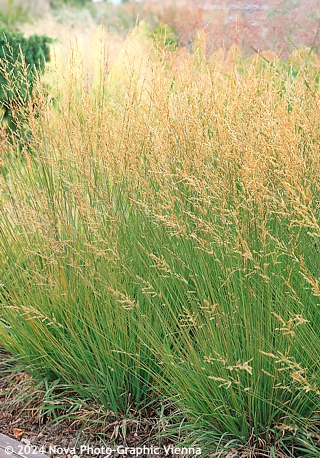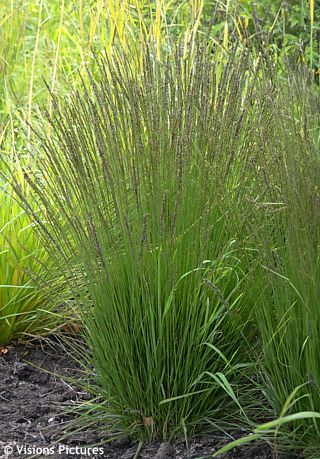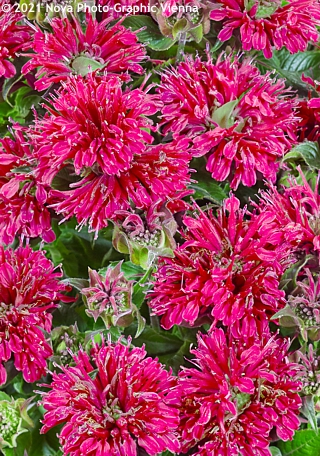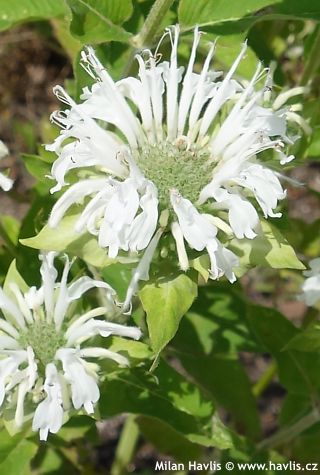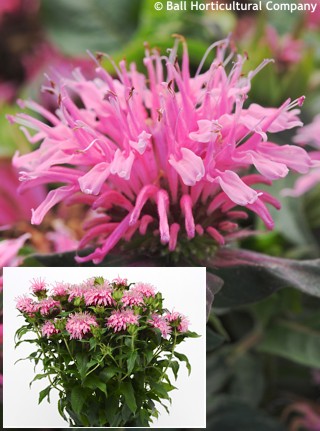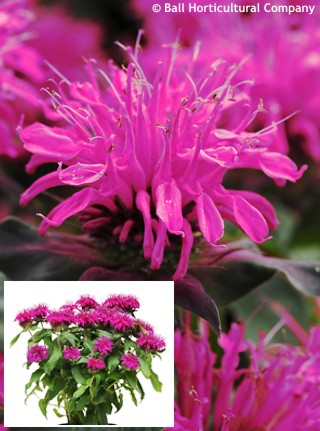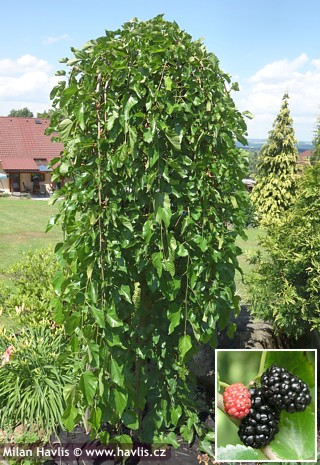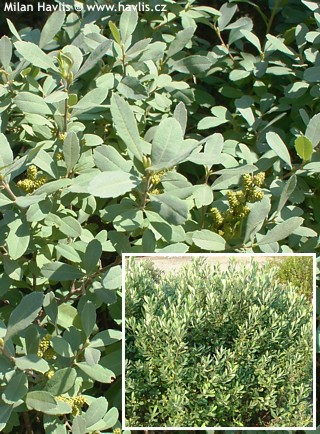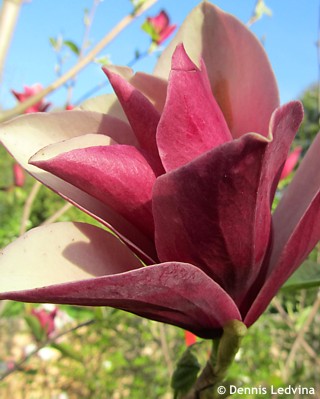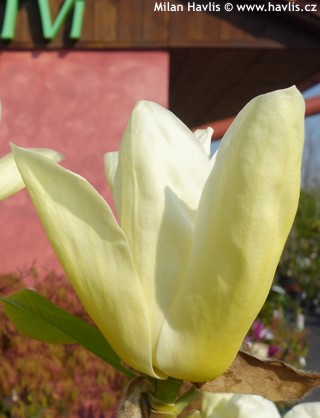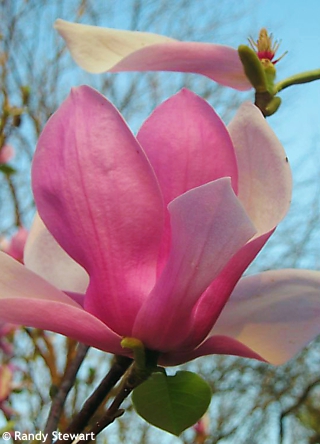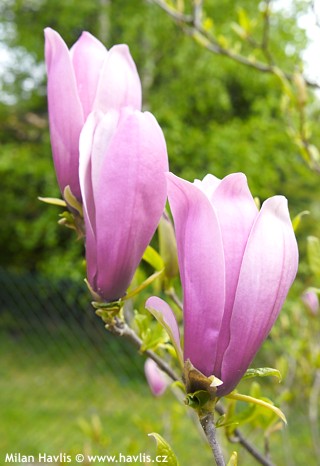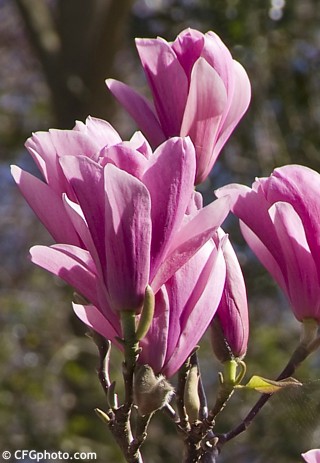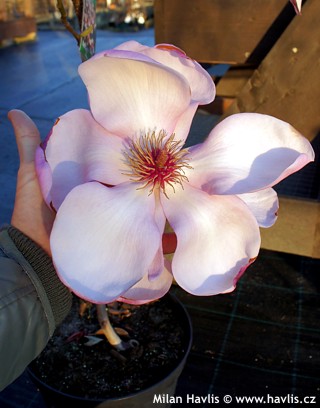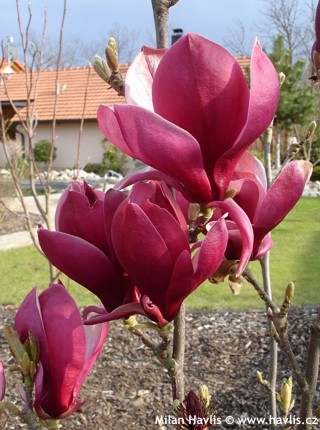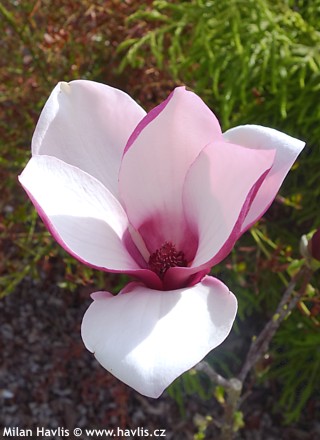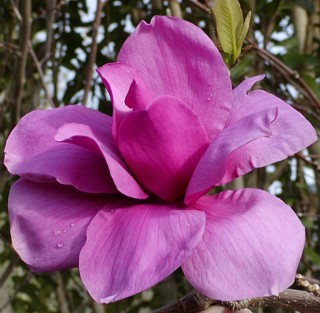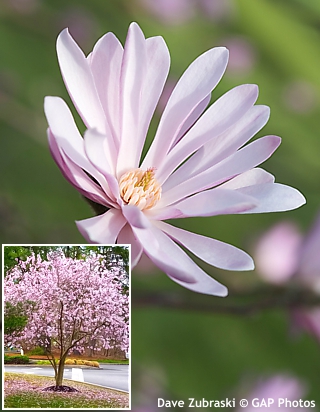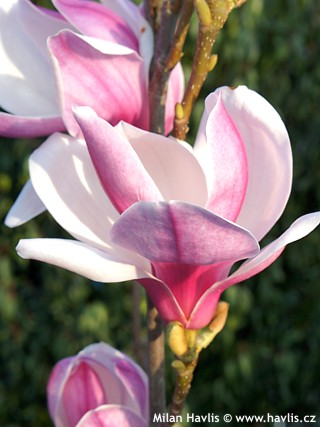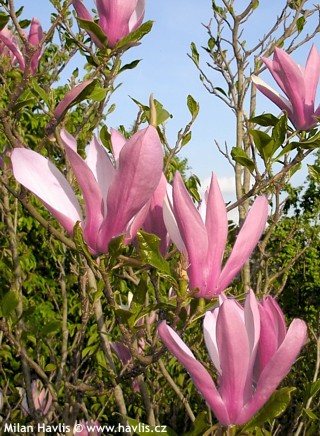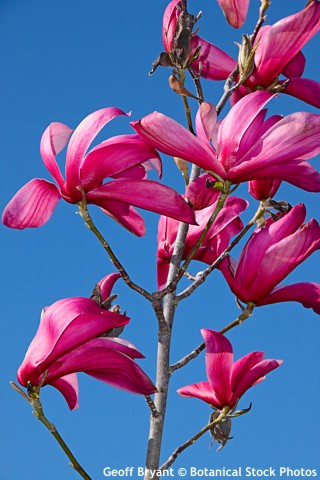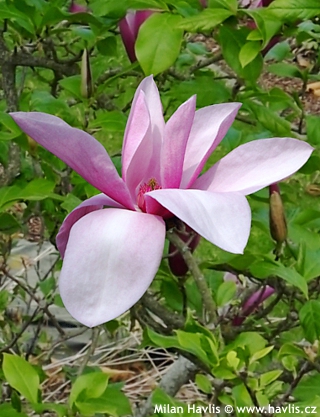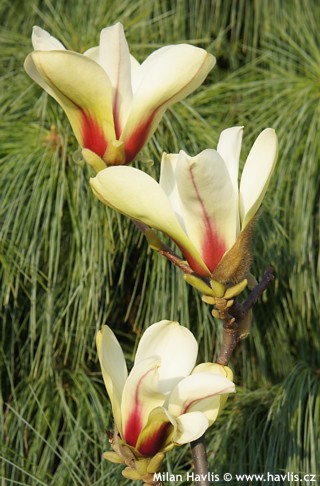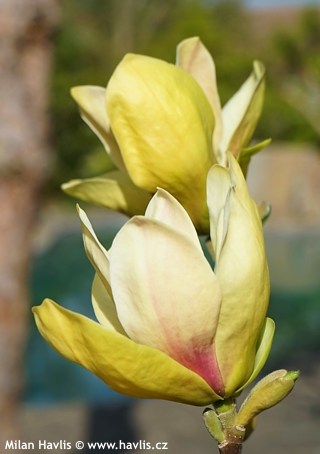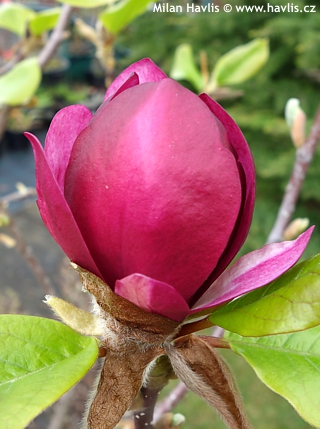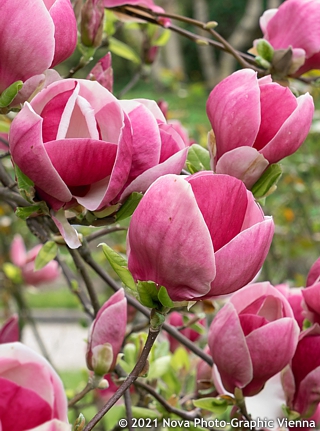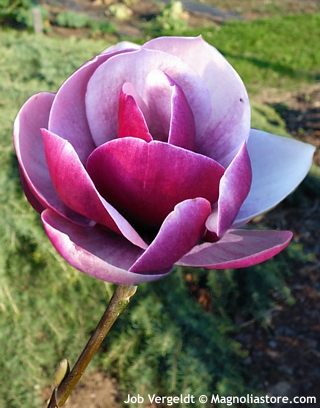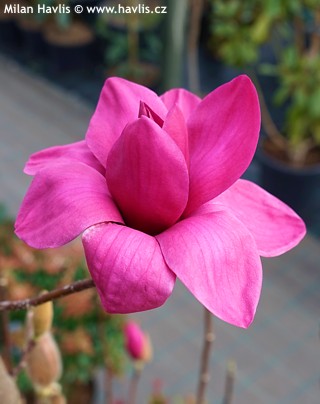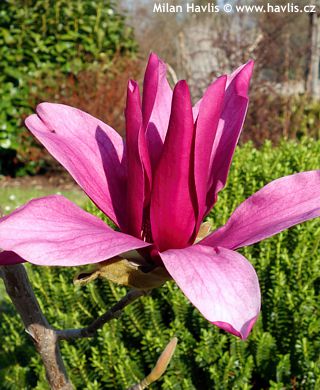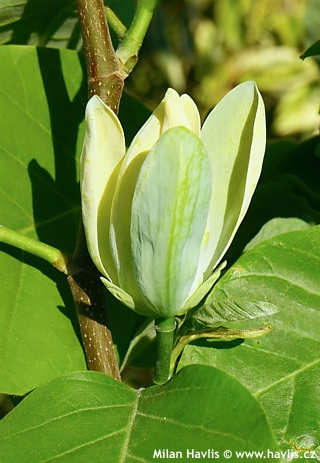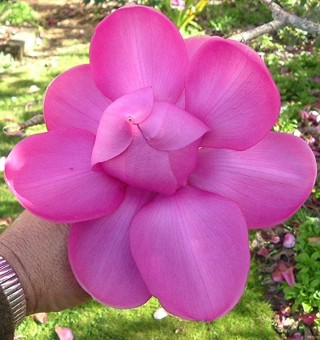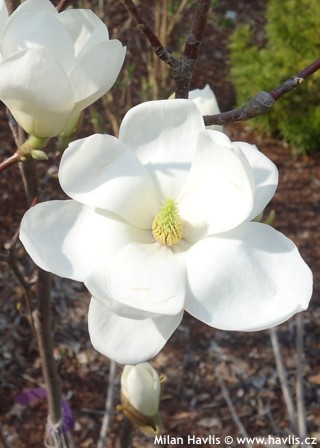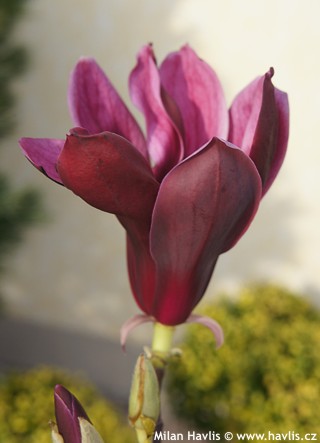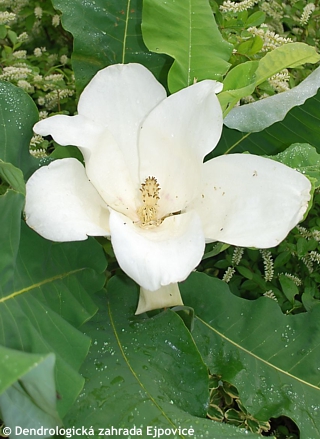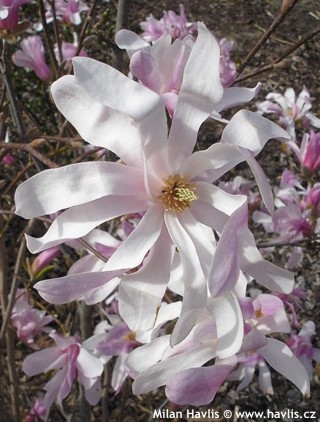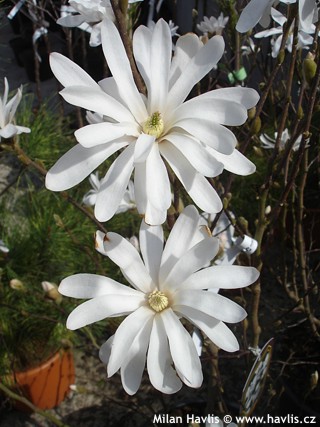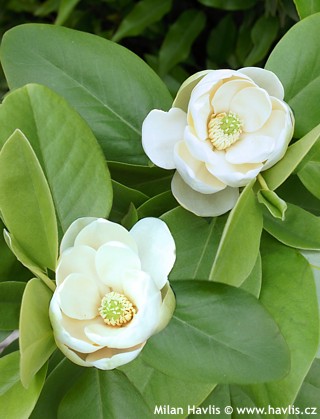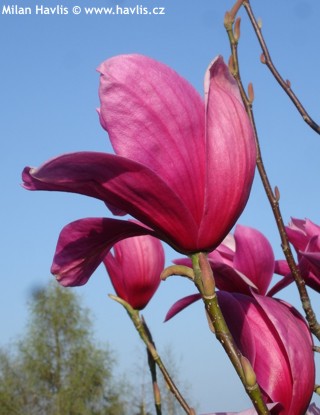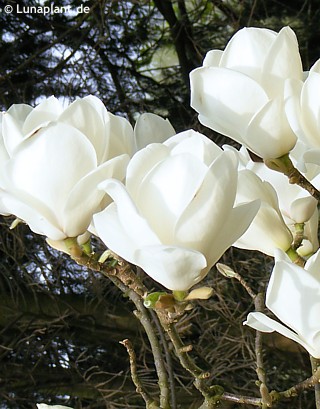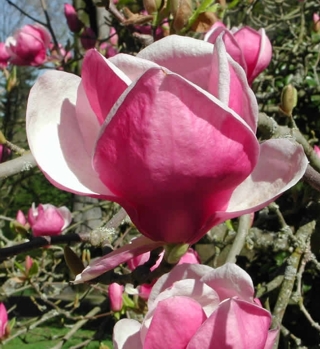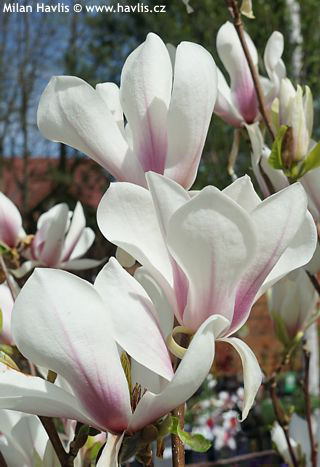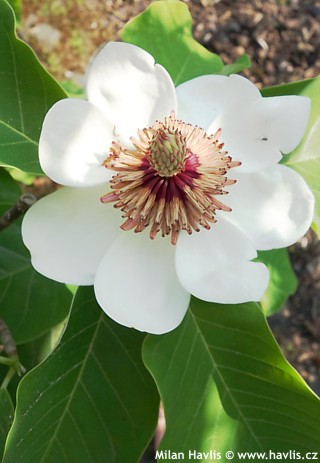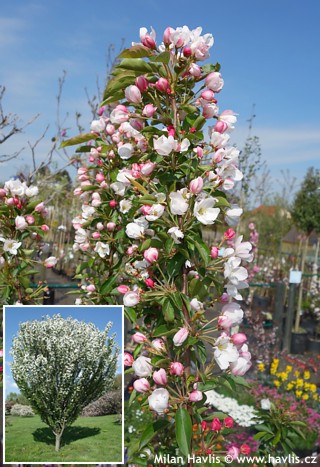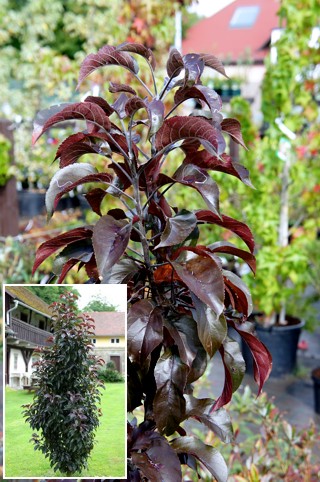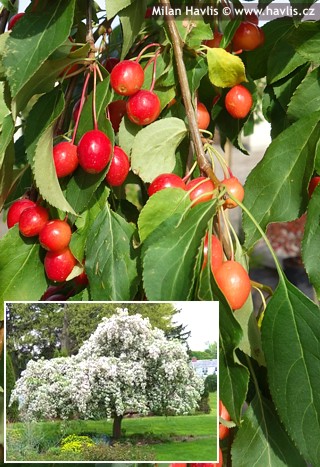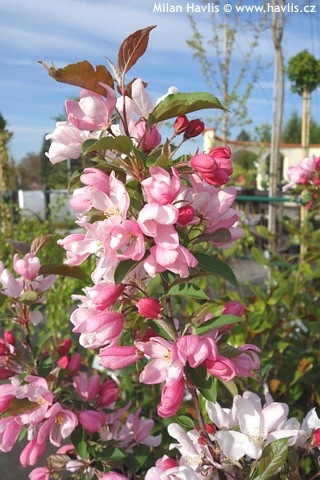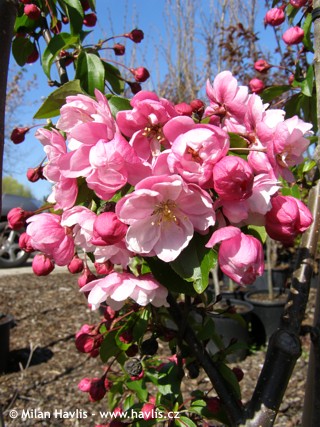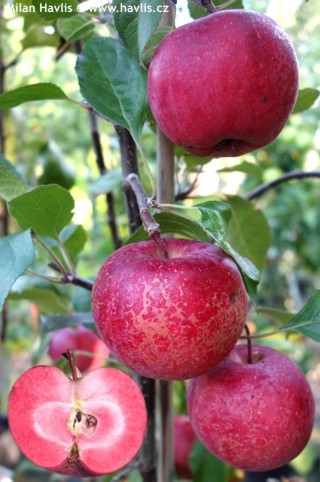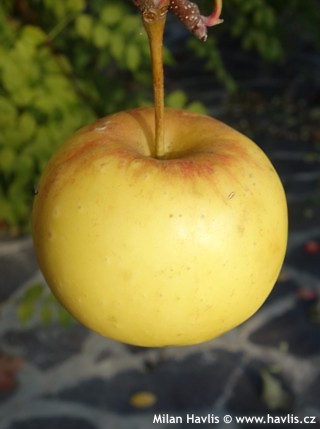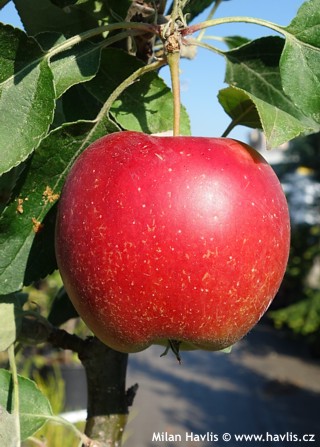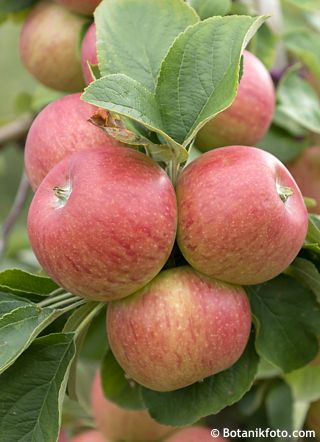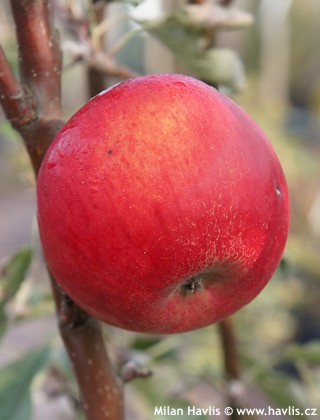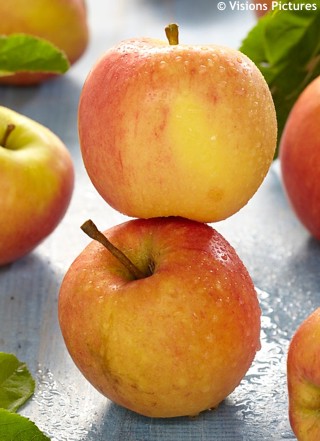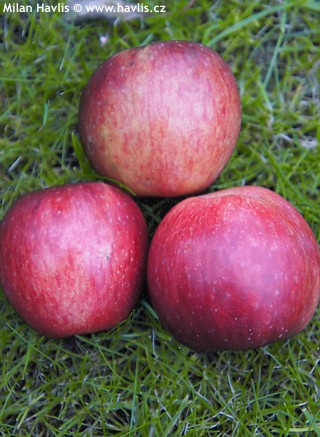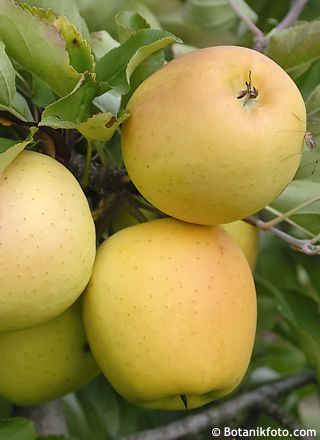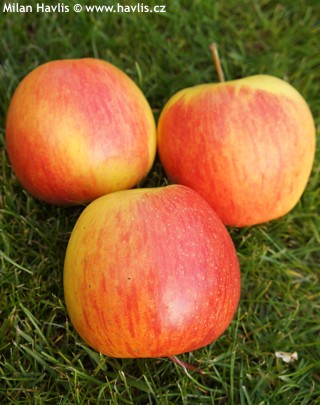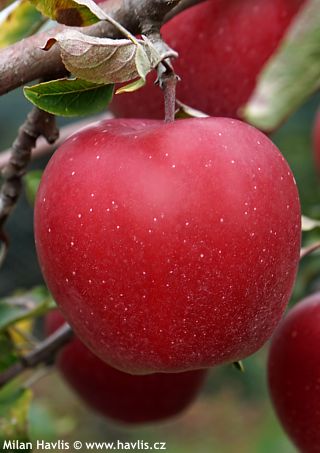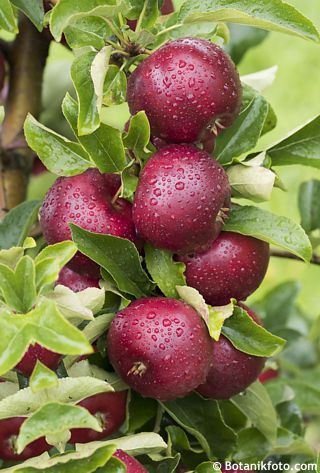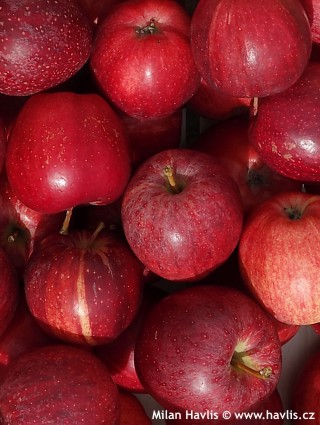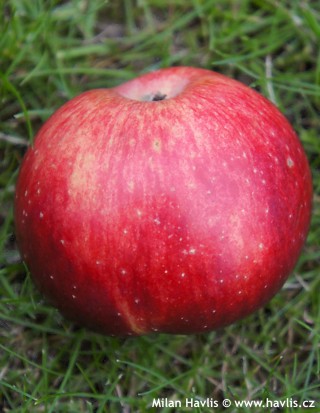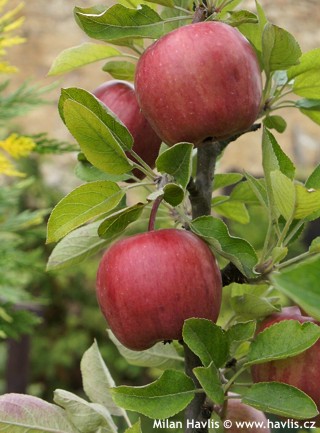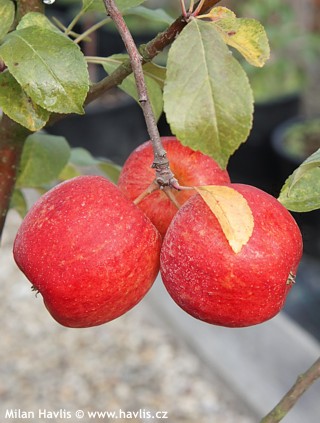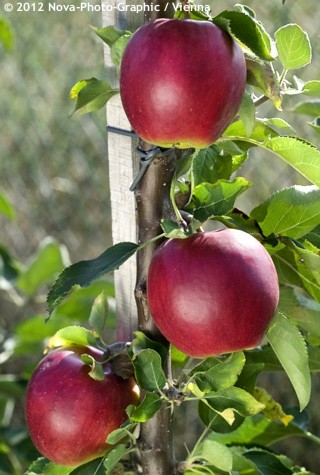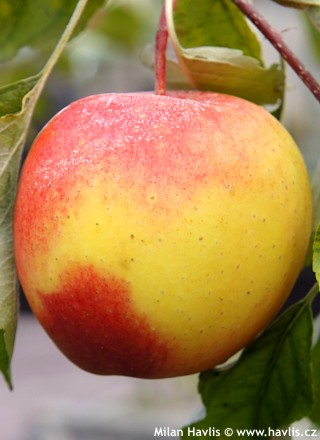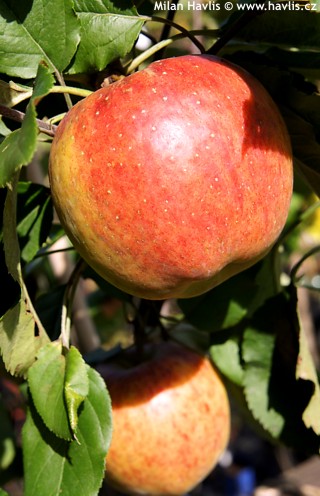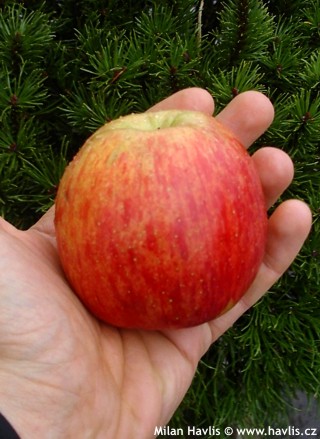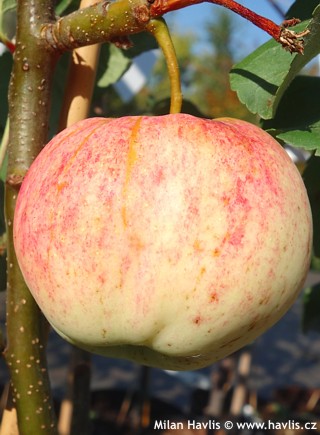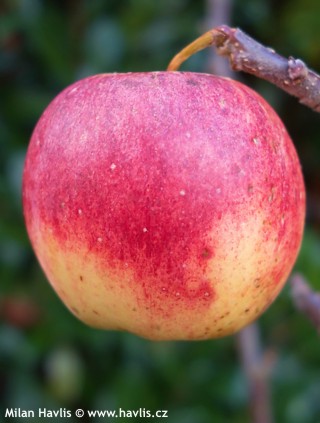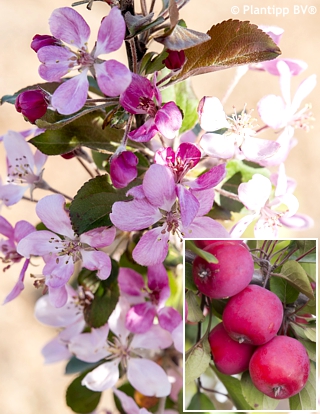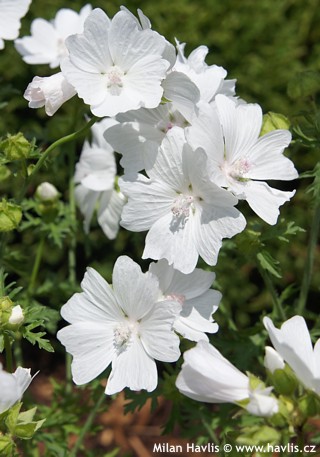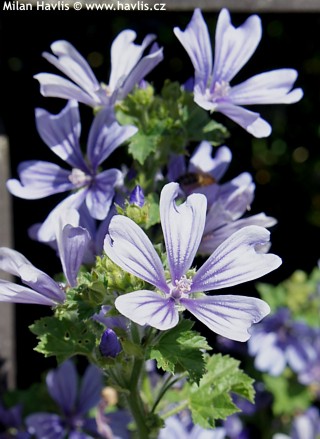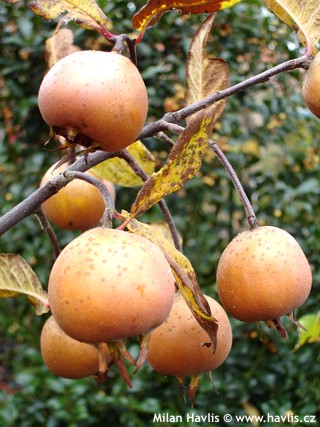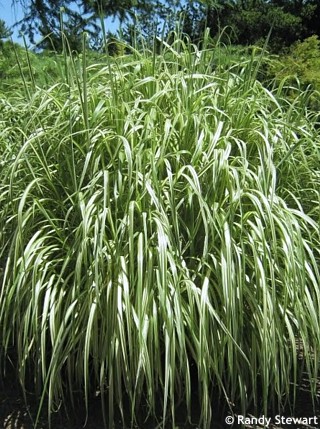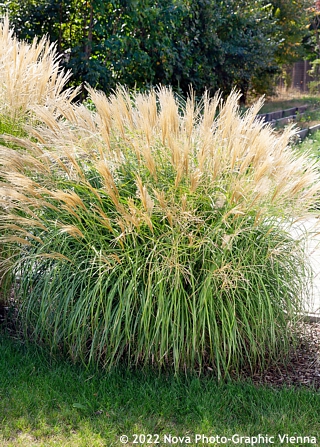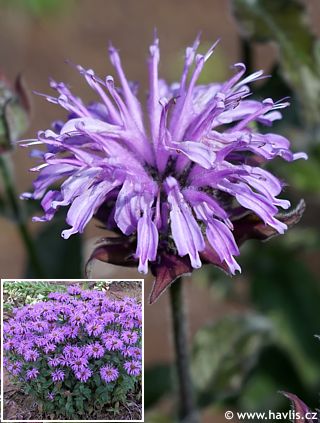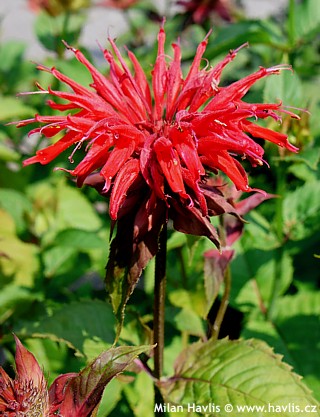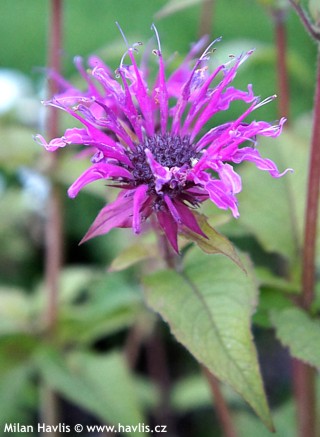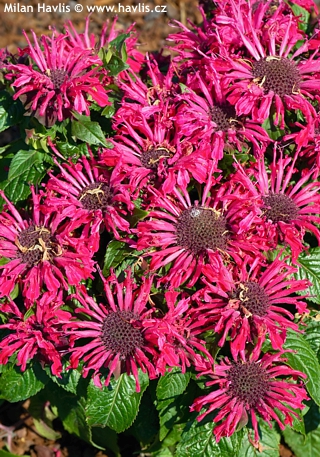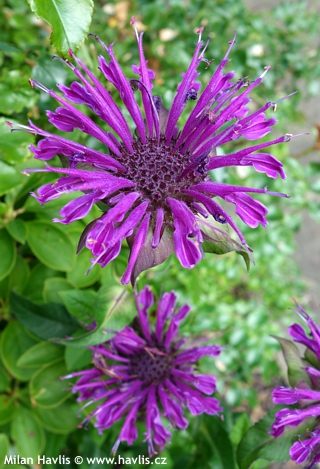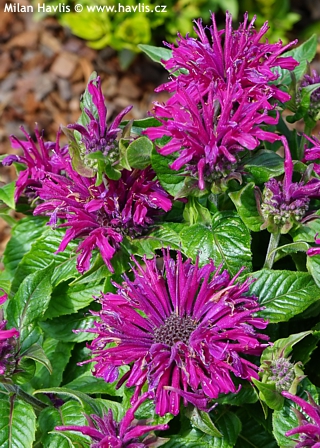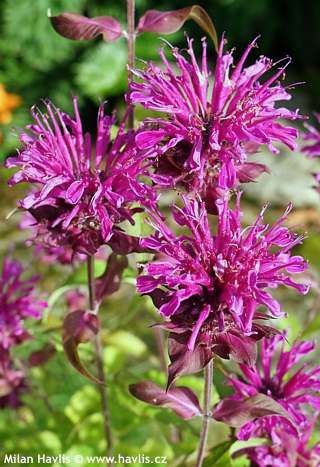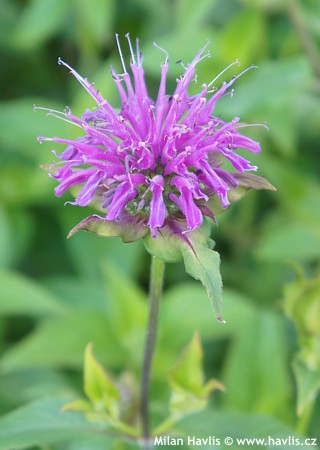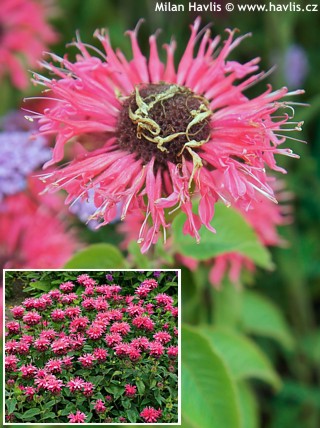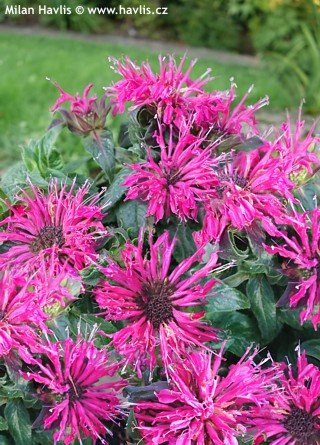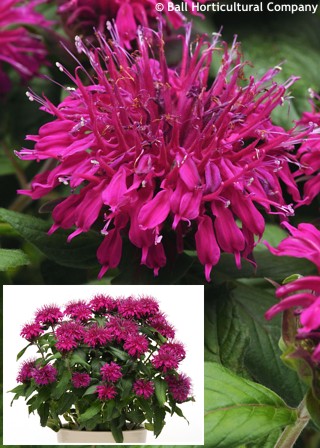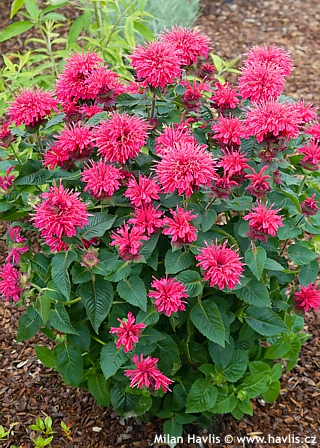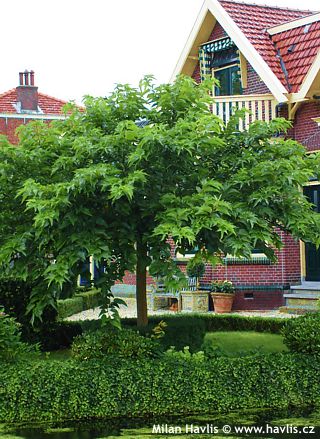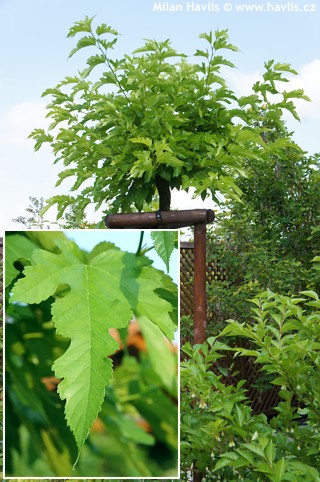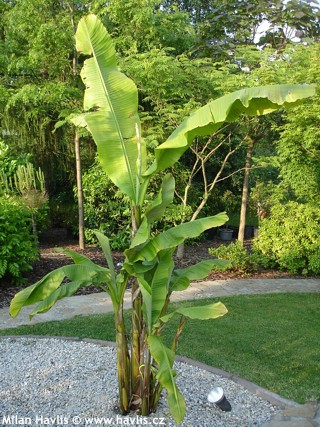CURRENTLY IN STOCK:
Athene is a large-flowered magnolia hybrid, a cross between magnolia „Mark Jury“ and magnolia x soulangeana „Lennei Alba“. The flowers have almost white petals with deep red or purple red shades at the bottom. They are very fragrant and reach 25-30 cm across when fully opened ...

IV - IV

3 - 4m

3 - 4m

full to partial sun

7 (down to -23°C)

for zone 5+6

for zone 7
Black Beauty magnolia is another brooklynensis hybrid from the Brooklyn Botanic Gardens, USA, which, surprisingly, does not bear yellow flowers. It is a cross of m.acuminata (cucumber magnolia with yellow flowers) and m.liliiflora (lily magnolia with rosy red flowers). It produces 10-20 cm tall, ere ...

IV

3 - 6m

2 - 3m

full to partial sun

5 (down to -29°C)

for zone 5+6

for zone 7
Are you a magnolia lover who thinks he has seen them all? Well, have another look at this almost blue magnolia. Of course it is slightly exaggerated, there are just blue hues in the bud, yet they are stunning.
Blue Opal magnolia is a selection from magnolia acuminata (so-called cucumber magnolia) ...

V - V

3 - 6m

2 - 3m

full to partial sun

5 (down to -29°C)

for zone 5+6

for zone 7
Another unique jewel among magnolias is this yellow flowering hybrid. It is a cross between m.denudata and m.acuminata (cucumber magnolia). It was raised by Phil Savage in Michigan, USA, in 1988 and patented three years later.
Medium-sized flowers are unusual and truly gorgeous. The colour is clea ...

IV - V

3 - 5m

3 - 5m

full to partial sun

5 (down to -29°C)

for zone 5+6

for zone 7
Cleopatra is another magnolia success by a renowned magnolia breeder Vance Hooper from New Zealand. It is a cross between Sweet Simplicity and Black Tulip varieties. The result is a rich purple red, large flower, almost 20 cm across with a lovely fragrance. In Central European climate it grows moder ...

IV - V

3 - 4m

2 - 3m

full to partial sun

7 (down to -23°C)

for zone 5+6

for zone 7
Columnar Pink is an admirable magnolia variety selected by famous English gardener Maurice Foster. His 15-acre large garden is located near Sevenoaks in Kent, U.K., a place about 500 meters above sea level which is sometimes called Kentish Alps since the rest of this south-eastern English county is ...

IV - V

3 - 4m

1 - 2m

full to partial sun

5 (down to -29°C)

for zone 5+6

for zone 7
Coral Lake is a chameleon magnolia changing colours during flowering. It is a cross between Legend (m. acuminata x m. acuminata ssp. subcordata, 1985) and Butterflies (m. acuminata x m. denudata ‚Sawada’s Cream‘, 1988). The most interesting fact about it breeding is that neither of ...

IV - V

3 - 5m

3 - 4m

full sun

4 (down to -34°C)

for zone 5+6

for zone 7
If you like the spring profusion of blooming magnolias, look at this yellow rarity. Probably the best yellow magnolia so far was raised by a Belgian breeder, Philippe de Spoelberch. It is a cross between ´Miss Honeybee´ a ´Gold Crown´.
It is called Daphne. Its flowers are deep yellow, long lasting ...

V - VI

1,5 - 3m

1 - 2m

full to partial sun

5 (down to -29°C)

for zone 5+6

for zone 7
Daybreak magnolia has a unique shade of pink. The flower buds are slim and tall, rich pink but not garish. They show small, flame-like triangles of green colour at the bottom of their calyxes. The buds take quite some time looking precious for many days before they open wide into fascinating, soft p ...

IV - V

3 - 5m

1,5 - 2m

full to partial sun

5 (down to -29°C)

for zone 5+6

for zone 7
Felix magnolia, also called Felix Jury, is a recent introduction by Mark Jury, and a gorgeous hybrid named after his late father who fortunately lived to see its first flowers, but not its worldwide success a few years later. It was made in 1984 as a cross between extremely large-flowered Atlas and ...

IV - V

2 - 3,5m

1,5 - 2m

full to partial sun

5b (down to -27°C)

for zone 5+6

for zone 7
Genie is a sensational new magnolia from New Zealand. After 15 years of breeding there is eventually a plant that holds its deep red-purple colour well and offers prolonged flowering period. The hybridizing process was truly awesome, if you are interested in how this jewel came to life follow its hi ...

V - VI

1 - 3m

1 - 3m

full to partial sun

5 (down to -29°C)

for zone 5+6

for zone 7
Another rare magnolia is this cross between magnolia acuminata var. subcordata “Miss Honeybee” and magnolia stellata. It gained flower shape fro stellata and colour from acuminate.
Goldstar has medium sized flowers with 14 narrow petals, very similar to star-shaped magnolias. The colour ...

IV - V

2 - 3m

full to partial sun

5 (down to -29°C)

for zone 5+6

for zone 7
Among deciduous magnolias there are varieties that bloom later than most of the Asian ones. This selection named Charles Coates originated in England in Kew, famous for its Kew Gardens, by crossing m.sieboldii and m.tripetala.It makes leaves first, and only at the end of spring it shows a magnificen ...

V - VI

3 - 5m

1,5 - 2,5m

full to partial sun

5b (down to -27°C)

for zone 5+6

for zone 7
Judith D. Zuk (1951-2007) was an American horticulturist and conservationist, a graduate of the prestigious Rutgers University, where many beautiful plants are bred, several of which have reached us, too. From 1990 to 2005, she served as president of the Brooklyn Botanic Garden, and during her tenur ...

IV - V

4 - 7m

1,5 - 2,5m

full to partial sun

5 (down to -29°C)

for zone 5+6

for zone 7
Livingstone magnolia is a cross between m. sprengeri ‘Diva’ and m. ‘Vulcan’. Sprenger’s magnolia is often used in hybridization for flower size and fragrance, and Vulcan was surely chosen for the colour. The result is splendid. A large flower of a vibrant purple red col ...

IV - V

4 - 6m

1,5 - 3m

full to partial sun

5b (down to -27°C)

for zone 5+6

for zone 7
Manchu Fan is a white flowering rare magnolia from New Zealand. It bears medium-sized, goblet-shaped flowers that are almost pure white with a very light pink smudge at the bottom. The petals look like fragile china and do not open up completely keeping the elegant goblet shape. The flowers open in ...

IV - V

3 - 6m

2 - 4m

full sun

5 (down to -29°C)

for zone 5+6

for zone 7
Maxine Merrill is a magnolia cross between m.acuminata ssp. subcordata ‚Miss Honeybee‘ and m. x loebneri ‚Merrill‘. It was bred by one of the greatest magnolia breeders Phil Savage from the USA. It produces medium-sized, cup-shaped flowers with 6 sturdy petals of soft banana ...

IV - V

4 - 5m

2 - 3m

full to partial sun

5 (down to -29°C)

for zone 5+6

for zone 7
Norman Gould is a compact growing Japanese magnolia hybrid. It makes 10 cm large, snow-white, goblet-shaped, fragrant flowers with 8-9 petals. They come out already from late March if the weather is nice. Deciduous leaves are 10-15 cm long, broadly ovate, mid green, and puckered. The plant forms com ...

III - IV

3 - 5m

2 - 3m

full sun

4 (down to -34°C)

for zone 5+6

for zone 7
Olivia magnolia was developed by August Kehr as a hybrid between the varieties Miss Honeybee and Gold Crown, and in 2003, two years after his death, it was selected and named by Koen Camelbeke and Philippe de Spoelberch from the Belgian Arboretum Wespelaar. It bears medium-sized flowers with a span ...

IV - V

3 - 5m

2 - 3m

full to partial sun

5 (down to -29°C)

for zone 5+6

for zone 7
Pink Charm is a pink-flowered and highly attractive magnolia variety that, along with Rose Marie, emerged from the crossing of Pink Surprise and Daybreak. It was bred and introduced by Dennis Ledvina in 2013. The flowers are bright pink on the outside, pale pink to almost white on the inside, and ha ...

IV - V

3 - 6m

2 - 3m

full to partial sun

5 (down to -29°C)

for zone 5+6

for zone 7
Purple Star magnolia is a modern variety from 2015 from the renowned Belgian breeder Phillippe de Spoleberch, whose perhaps the greatest success, with which he gained fame around the world, is Daphne magnolia, so far considered the best deep yellow available. Purple Star is a cross between m. cylind ...

IV - V

3 - 6m

2 - 3m

full to partial sun

7 (down to -23°C)

for zone 5+6

for zone 7
Satisfaction is a European novelty among magnolias from 2002. Its origin is not known, however, so far it has proven to be a real winner.
Satisfaction is a small or mid-sized magnolia with mid-sized to large blossoms. The outside colour is deep burgundy red and pure white inside. The cup-shaped fl ...

IV - IV

1 - 3m

full to partial sun

5 (down to -29°C)

for zone 5+6

for zone 7
Shirazz (two zeds) is a lush magnolia variety from New Zealand. It is a cross between magnolia denudata and magnolia Vulcan. The result is a profusion of vibrant claret red flowers with paler interior. They are fragrant and come out along strictly upright branches like closed tulips, opening wide a ...

IV - IV

3 - 5m

1,5 - 2m

full to partial sun

5 (down to -29°C)

for zone 5+6

for zone 7
Susan magnolia has narrow, goblet-shaped flowers of deep pink, nearly red colour outside and slightly lighter red inside. This is the reddest coloured variety among spring magnolias. It flowers reliably already when young. It does not require pruning at all. As it has flower buds at the ends of last ...

IV - V

1,5 - 3m

1 - 2m

full to partial sun

5 (down to -29°C)

for zone 5+6

for zone 7
This magnolia variety has only recently been imported from China, under the name Fei Huang. It is a sensational plant with large yellow flowers. It belongs to magnolia denudata (Yulan magnolia) group, however, we have not been able to search for the exact breeding details. The Chinese probably keep ...

V - V

3 - 5m

2 - 3m

full to partial sun

5 (down to -29°C)

for zone 5+6

for zone 7
Another jewel among magnolias came from New Zealand, again, and was raised by Mark Jury. Its name is Black Tulip® and has been sought after thanks to its very deep purple colour of flowers. They are rich purple in colour, not too large – only about 10-15 cm across, goblet-shaped making a ...

V - V

3 - 5m

1 - 2m

full to partial sun

5 (down to -29°C)

for zone 5+6

for zone 7
Red As magnolia (sometimes referred to as Red As Red) by Ian Baldick is a hybrid between the varieties Pickard’s Ruby and Vulcan and has been on the market since 2004. It produces stunning, chalice-shaped flowers of a deep purple-red colour especially on the outside, and a tone paler inside, a ...

IV - V

3 - 4m

2 - 3m

full to partial sun

7 (down to -23°C)

for zone 5+6

for zone 7
Golden Gift is a magnolia crossing between m. acuminata ‘Miss Honeybee’ and (m. acuminata x m. denudate) which makes it obvious that thanks to a lot of genes of cucumber magnolia (m. acuminata) the flowers should be yellow. And they are! They are 6-petalled, mid-sized, tulip-shaped, soft ...

IV - V

3 - 4m

2 - 3m

full to partial sun

5 (down to -29°C)

for zone 5+6

for zone 7
Japanese magnolia belongs among the tallest, fastest growing, and the hardiest magnolias of the planet. It is native to Japan (and Korea) where it was named after Japanese word kobushi which means fist and relates to the shape of opening flower buds. Flowers are about 10 cm across, goblet- to saucer ...

IV

6 - 12m

6 - 8m

full sun

4 (down to -34°C)

for zone 5+6

for zone 7
This is one of the latest varieties of spring magnolias opening its flowers in May, thus avoiding late frosts that may damage flower petals or entire buds. Nigra’s petals are dark burgundy-purple on the outside and very light purple or nearly white on the inside. The goblet-shaped flowers are ...

V - V

2,5 - 3,5m

1 - 2m

full to partial sun

5 (down to -29°C)

for zone 5+6

for zone 7
With the new millennium, large-flowered magnolias seem to have become a new fashion for broad public and collectibles for magnolia enthusiasts. The number of new cultivars increases every year. EMPEROR is an impressive one from New Zealand based breeder Vance Hooper. It is a cross between Felix Jury ...

IV - V

3 - 5m

1,5 - 2,5m

full to partial sun

7 (down to -23°C)

for zone 5+6

for zone 7
Discovering magnolia STARBURST was a thrill. Not only has it gorgeous flowers, but it also has something very practical for small gardens – narrower, almost fastigiate habit. Its fragrant flowers are 15-20 cm across, purple red on the outside and much paler inside with pink stars airbrushed on ...

IV - V

2 - 4m

1 - 2m

full to partial sun

7 (down to -23°C)

for zone 5+6

for zone 7
Star magnolia is a one of the earliest magnolias to flower in March already. It has star-shaped, pure white flowers with a lovely scent. As it blooms on bare branches early in the spring we recommend placing it in front of an evergreen shrub, e.g. cherry laurel, holly, or any bright green conifer, t ...

III - IV

2 - 4m

1 - 3m

full to partial sun

5 (down to -29°C)

for zone 5+6

for zone 7
Umbrella magnolia is a unique plant of its species. It is quite unusual though easy to grow. Its main feature are exotic-looking, large leaves that can grow 30-45 cm long. Their colour is mid-green flashed with bronze from spring to early summer. They are soft and slightly hairy beneath, crowded at ...

V - VI

6 - 10m

full to partial sun

5 (down to -29°C)

for zone 5+6

for zone 7
Bloomfield is a sensational new variety of an already fantastic umbrella magnolia. Though quite unique this plants is so easy to grow and needs no or very little care. This variety produces even larger leaves than the species, they can be up to 60 cm long. They are deciduous, mid-green flashed with ...

V - VI

6 - 10m

3 - 6m

full to partial sun

5 (down to -29°C)

for zone 5+6

for zone 7
Hattie Carthan magnolia was bred by Doris Stone from the Brooklyn Botanic Garden by cross-pollinating several unnamed m. x brooklynensis hybrids (m.acuminata x magnolia x liliiflora) and ‘Evamaria’ variety. The result was a stunning magnolia with firm flowers of elongated tepals. They ar ...

IV - V

4 - 7m

1,5 - 3m

full to partial sun

5 (down to -29°C)

for zone 5+6

for zone 7
Woodsman is more than a lumberjack. In a broader sense, he's also someone who takes care of the forest and its trees, not seeing them as a commodity. He loves and appreciates them. People connected with occupations such as woodsman or lumberjack are often described in a manly manner which nowadays ...

V

2 - 4m

1,5 - 2,5m

full to partial sun

5 (down to -29°C)

for zone 5+6

for zone 7
“Yellow Bird” magnolia is a cross between magnolia acuminata and magnolia brooklynensis “Evamaria” from 1967. Yet that year it was suggested the best yellow cultivar so far. Well, a lot of time has passed and these days there are a few more girls to ask that honour that we co ...

V - V

3 - 6m

full to partial sun

5 (down to -29°C)

for zone 5+6

for zone 7
If you like strong and sweet perfume of magnolia flowers do not miss out on Mag’s Pirouette. It is a seedling of Ballerina variety and was found by Tetsuo Magaki in Japan. It is as slender and beautiful as a ballet dancer and produces snow white, semi-double to double flowers. Their petals are ...

IV

3 - 4m

1,5 - 2m

full to partial sun

5 (down to -29°C)

for zone 5+6

for zone 7
Wildcat is a beautiful and unique fully double flowered magnolia hybrid. It produces white, chrysanthemum-like, 10 cm wide flowers with some pinkish hues. It has an advantage of 1-2 weeks later flowering as opposed to star magnolias (m.stellata) which can be damaged during early flowering by late ni ...

IV - IV

3 - 4m

2 - 3m

full to partial sun

5b (down to -27°C)

for zone 5+6

for zone 7
Proctor magnolia is a hybrid of two Japanese magnolia species – m. stellata and m. salicifolia. It is distinguished by early flowering and profusion of star-shaped, white, fragrant flowers, larger than on m. stellata, with less petals but of firmer appearance. Slavin’s Snowy is a selecti ...

III - IV

6 - 8m

3 - 4m

full to partial sun

5 (down to -29°C)

for zone 5+6

for zone 7
It was in 1826 when the very first bloom of this famous saucer magnolia came into the world. It was bred by French botanist Etienne Soulange-Bodin who 6 years before that success made a cross between m.denudata and m.liliflora. It blooms on bare branches with beautifully scented, goblet- or saucer ...

IV - V

4 - 8m

semi-shade / partial sun

5 (down to -29°C)

for zone 5+6

for zone 7
If you are a magnolia lover who still has some space in the garden which is a rare combination, have a look at this immense beauty in white named Alba Superba. It is a reliable and hardy variety of saucer magnolia. If the weather is nice, from mid April (in zone 6) begins to open its profusion of me ...

IV - V

4 - 6m

3 - 4m

full to partial sun

5 (down to -29°C)

for zone 5+6

for zone 7
Alexandrina is a very popular variety of saucer magnolia. Thanks to the rich colour of outer petals it is rated commercially best-selling saucer magnolia. The flowers are upto 10 cm across, white inside, flushed deep pink and purple outside, with a lovely fragrance.
Deciduous leaves are rather obo ...

IV - IV

4 - 6m

full to partial sun

5 (down to -29°C)

for zone 5+6

for zone 7
Thompson magnolia boasts large, creamy white, very fragrant flowers which come out from June until July on a fully leafed out plant. The flowers are up to 15 cm across and the fragrance is deep and sweet. Deciduous leaves are broadly ovate to obovate, 15-25 cm long, fresh green above and glaucous be ...

VI - VII

3 - 5m

2 - 3m

full sun

7 (down to -23°C)

for zone 5+6

for zone 7
Golden Hornet is a well known crabapple variety with rich butter yellow fruit. It produces masses of slightly fragrant, white blossoms opening from pink buds in May, which are followed by spherical, bright yellow, glossy fruit which is in fact tiny apples that can be eaten if you like somewhat astri ...

V

5 - 8m

5 - 8m

full sun

5 (down to -29°C)

for zone 5+6

for zone 7
Profusion crab apple is a hybrid, sometimes classified as malus x moerlandsii. It comes from the Netherlands.
Its main feature are dark purple-pink flowers that come out from mid to end spring in profusion. They are followed by small, spherical fruit of purplish-black colour and look like wild che ...

IV - V

2 - 5m

2 - 5m

full to partial sun

4 (down to -34°C)

for zone 5+6

for zone 7
Red Sentinel is a beautiful crabapple variety with scented, white blossoms opening from pink buds. It flowers from early May and in autumn produces profusion of rich red, sometimes yellow flushed fruit that is not edible for humans but delicious for birds.
Leaves are deciduous, broadly ovate, dark ...

IV - V

4 - 6m

3 - 5m

full sun

5 (down to -29°C)

for zone 5+6

for zone 7
Some crab apples can easily compete with Japanese ornamental cherries as far as the beauty and colours of their flowers. This is the case of ´Royal Beauty´. It is a small tree growing about 2.5m tall, with weeping, somewhat narrow crown. In the spring it brings a profusion of deep pink to light purp ...

IV - IV

2 - 3m

full sun

4 (down to -34°C)

for zone 5+6

for zone 7
Coccinella® is a relatively new variety of crab apple. It is protected as a registered trademark and its features speak for itself. The flowers are pale to rich purple, with tints of red rather than pink as on ornamental cherries. Moreover, this selection has burgundy leaves and dark red branch ...

IV - IV

3 - 5m

full sun

4 (down to -34°C)

for zone 5+6

for zone 7
Bolero columnar apple tree makes medium-sized, rounded to slightly cylindrical fruits with a smooth, green skin that turns yellow as it ripens and takes on faint red tones. The flesh is almost white and its taste is best compared to James Grieve – very juicy, crispy, and pleasantly sweet with ...

IV - V

2 - 3m

0,4 - 0,5m

full sun

5 (down to -29°C)

for zone 5+6

for zone 7
Fuji is a remarkable jabloně of great popularity. It was bred in Fujisaki, Japan, in 1939 as a cross between Red Delicious and Virgina Ralls Genet. Thanks to its qualities it became the top selling and favourite apple of Japan and since late 1960’s when it was introduced to the world it has ga ...

IV - V

2 - 3m

1,5 - 2,5m

full sun

5 (down to -29°C)

for zone 5+6

for zone 7
Golden Delicious is a favourite apple brand. It comes from the USA, 1890. The fruit is sweet, juicy and crisp, of golden yellow to greeny-yellow colour. Its size is dependent on soil fertility. The fruit can be very large.
It is usually trouble-free as far as late frosts and is disease resistant. T ...

IV - V

3 - 6m

full sun

4 (down to -34°C)

for zone 5+6

for zone 7
Granny Smith is a famous apple variety from Australia from late 1800´s. It is renowned for sharp flavour and tough, lime green skin. Fruit eaten fresh is chrunchy and juicy. Thanks to firm texture it is ideal for cooking as it keeps its shape. Fruit matures late and stores well.
Granny Smith apples ...

IV - V

3 - 6m

2 - 4m

full sun

4 (down to -34°C)

for zone 5+6

for zone 7
Jonagold is a great dessert apple variety that combines the best of both its parents. It has the sweetness of Golden Delicious as well as mild sharpness and aroma of Jonathan. The flesh is crispy and very juicy. Moreover, Jonagold is a very attractive apple to look at – it is honey yellow with ...

IV - V

2 - 4m

2 - 3m

full sun

for zone 5+6

for zone 7
Melrose is an attractive and tasty late apple. It is a result of crossing Jonathan and Red Delicious. The apples are sweet and crunchy. Their colour is red. Ideal snack apple or for cooking. Tastes best about one month from picking. It can be stored until end February.
Apple trees should be pruned ...

IV - V

3 - 6m

2 - 4m

full sun

for zone 5+6

for zone 7
Polka columnar apple tree makes medium-sized, rounded to slightly cylindrical fruits with a pale green skin that changes to rosy red as it ripens. The flesh is almost white and its taste is best compared to Spartan – very juicy, crispy but firm, and pleasantly sweet with low acidity. It mature ...

IV - V

2 - 3m

0,4 - 0,5m

full sun

5 (down to -29°C)

for zone 5+6

for zone 7
This is probably the earliest apple in our climate, of Russian origin from around 1800. Its name is different in every country, the English name is White Transparent. It produces good crops of medium-large to large fruit with greenish-yellow, soft skin and very juicy flesh that can be quite sharp fo ...

IV - V

2 - 4m

1,5 - 3m

full sun

5 (down to -29°C)

for zone 5+6

for zone 7
Redcats is a columnar apple variety with deep red fruit of excellent flavour. It resembles Gala variety. It is medium-sized, rounded, the flesh is firm and crisp, juicy, with a good sweet/sour balance. The fruit is resistant to scab, canker, and powdery mildew. Redcats a midseason variety can be pic ...

IV - V

2 - 3m

0,4 - 0,5m

full sun

5 (down to -29°C)

for zone 5+6

for zone 7
Rode Boskoop (Boskoop Red) is a red version of an old and popular Dutch variety of Belle de Boskoop late apple. It produces incredibly large fruit that can weigh up to 250g. It is often irregular or rounded with ribs. The skin is tough, rich red on most parts, and the flesh is pale yellow-green matu ...

IV - V

2,5 - 3,5m

2 - 3m

full sun

7 (down to -23°C)

for zone 5+6

for zone 7
Malus Perpetu® is another crab apple. This variety offers snow-white flowers, very similar to those you can see on apple trees. They open from pink buds and their number is very high every year. Deciduous leaves are green, ovate, mid-sized. The best attraction is the fruit – many tiny app ...

IV - V

3 - 5m

2 - 3m

full to partial sun

4 (down to -34°C)

for zone 5+6

for zone 7
Scarlet crabapple is a fantastic addition to the collection of spring flowering apples and cherries. This one, however, has more than one feature to look at (just like Scarlett Johansson who may have been a reason for giving this tree its name …)
Scarlet is a flowering crabapple tree with pro ...

IV - V

4 - 6m

2 - 5m

full sun

5 (down to -29°C)

for zone 5+6

for zone 7
Trilobata crabapple is a rare and unusual plant that is not difficult to grow butyet quite difficult to source. Its most specific feature is the leaf shape – it looks like a merge between maple and hawthorn. The leaves are not large but their prominent lobes are a good giveaway. They are decid ...

VI - VI

7 - 13m

2 - 5m

full to partial sun

5b (down to -27°C)

for zone 5+6

for zone 7
Shuttlecock fern (ostrich fern) is one of the most common ferns of European origin. It grows in our woodlands, in shaded areas and on wet meadows.
It has erect, light green fronds that under ideal conditions can grow 1.5m tall, but are usually shorter in cultivation, reaching some 80 cm. It spreads ...

0,6 - 1m

0,3 - 0,4m

full sun to shade

4 (down to -34°C)

for zone 5+6

for zone 7
Nottingham is an English medlar variety renowned for its rusty brown fruit of apple and pear flavour. The fruit is a little flattened at the end and about the same size as those on the species. It is edible only after the first frosts, or if picked early it should be bletted in room temperature in o ...

V - VI

3 - 4m

2 - 4m

full to partial sun

5 (down to -29°C)

for zone 5+6

for zone 7
Adagio is a dwarf variety of eulalia (maiden grass) as it does not grow taller than some 70 cm in leaf, and slightly over one meter in bloom. Leaves are dark green, elegantly narrow, and emerge late in spring, often in May. From August open plume-like inflorescences composed of soft sand yellow to p ...

VIII - IX

0,5 - 0,8m

1 - 1,5m

full sun

4 (down to -34°C)

for zone 5+6

for zone 7
Flamingo is an eulaila variety of a graceful habit. It has deep green, glossy leaves with a conspicuous white stripe in the middle. In autumn they quickly gain purple shades and later turn fiery orange. Glossy, wine red flowers are borne late in the season, and open just above the horizon of leaves ...

IX - X

1,5 - 1,8m

1 - 1,5m

full sun

5 (down to -29°C)

for zone 5+6

for zone 7
Gold Bar® is a very attractive mutation of popular zebra grass which exhibits a shorter, more compact growth with more profuse yellow variegation. Gold Bar® eulalia has 4 times as many yellow stripes than zebra grass and its tuft is very dense even on young plants. Flowers are not common b ...

0,8 - 1,3m

0,6 - 1m

full to partial sun

5 (down to -29°C)

for zone 5+6

for zone 7
Gracillimus is a maiden grass (eulalia) which is very popular among both interior as well as landscape designers. It offers a lush effect of dense tufts of narrow, rich green leaves, elegantly arching. It is not very tall but can be quite substantial given the space in your garden. Tassel-like flowe ...

IX - X

1,5 - 2m

1 - 2m

full sun

4 (down to -34°C)

for zone 5+6

for zone 7
Little Zebra® is an eulalia variety which is commonly supposed to be a dwarf version of Zebrinus, an older eulalia variety, however, these two have nothing in common. Little Zebra® originated as a natural sport of green-leaved miscanthus species. It has the same creamy white to pale yellow ...

VIII - IX

0,8 - 1,3m

0,8 - 1,3m

full sun

5b (down to -27°C)

for zone 5+6

for zone 7
Morning Light is an almost silver-leaved variety of eulalia. Its long leaves have white margins but they are so narrow that this colour overtakes the green centre, giving a silvery appearance to the whole clump. In the middle of summer it makes reddish-bronze flowers. It is best grown in sunny and w ...

VI - VIII

0,5 - 1m

full sun

5 (down to -29°C)

for zone 5+6

for zone 7
Red Chief is another red-flowering eulalia variety. In September it produces deep maroon red flowers high above fine foliage. Leaves are rather narrow, elegant, glossy, deep green in summer and gaining red shades in late summer and autumn when the whole clump becomes bronze red. Only about 1.5m tall ...

IX - X

1 - 1,5m

1 - 1,5m

full sun

5 (down to -29°C)

for zone 5+6

for zone 7
Ferner Osten is a German expression for Far East and a variety name of this maiden grass. It is popular for shorter growth and attractive colours. Its leaves are narrow, medium green in summer, and coppery orange and red in autumn. In late August rise about 1.5m tall stems with almost maroon flowers ...

VIII - IX

1 - 1,5m

1 - 1,5m

full to partial sun

4 (down to -34°C)

for zone 5+6

for zone 7
RED CLOUD® miscanthus is one of very few varieties producing weeping inflorescence. Already in midsummer it forms rich burgundy red, glossy plumes which are not erect as most other eulalias. Their colour is intense and is best viewed against afternoon sun. In early autumn the flowers open into fluff ...

VIII - IX

0,8 - 1,3m

0,5 - 0,8m

full sun

5b (down to -27°C)

for zone 5+6

for zone 7
Giant miscanthus, or also called mammoth miscanthus is possibly the tallest of all eulalias. It is a natural hybrid between m.sinensis and m.sacchariflorus. It makes up to 4m tall, strong stems within one growing season (after 3 years of growing). They are strong and sturdy. Leaves are wide, rich gr ...

3 - 4m

1 - 1,5m

full sun

4 (down to -34°C)

for zone 5+6

for zone 7
Moorflamme belongs among medium-tall varieties of purple moor grass and boasts profuse, yet delicate inflorescences atop slender stems slightly over one meter high. The inflorescences are conspicuously separated from the low clump of leaves and sometimes make an impression as if they had nothing to ...

VI - VIII

0,8 - 1,2m

0,3 - 0,5m

full to partial sun

4 (down to -34°C)

for zone 5+6

for zone 7
Torch is a valued variety of purple moor grass that offers slender and very compact upright clumps that don't arch. The leaves are deciduous, thin, strap-like, bright green, only about 30-40 cm high, and form a dense, low bunch from which shoot up thin stems that reach a height of about one meter in ...

VI - VIII

0,8 - 1,2m

0,3 - 0,4m

full to partial sun

4 (down to -34°C)

for zone 5+6

for zone 7
Cranberry Lace® is another dwarf beebalm variety from bred by Hubertus Gerardus Oudshoorn from the Netherlands as a cross between other dwarf varieties Cranberry Lace® and Pink Lace®. It forms neat and very compact tufts with upright branches holding bright purple flowers that are not ...

VIII - X

0,3 - 0,5m

0,3 - 0,5m

full sun

5 (down to -29°C)

for zone 5+6

for zone 7
Schneewittchen is a German translation of ‘Snow White’ as well as a variety name of this beebalm. It is as slender and upright as an image of a charming girl of exceptional beauty. Its pure white flowers sit atop almost a meter tall, bright green stems and come out from July until the la ...

VII - X

0,8 - 1m

0,3 - 0,5m

full sun

4 (down to -34°C)

for zone 5+6

for zone 7
BALMY™ LILAC is a beebalm from the BALMY™ series developed by Scott Trees for Ball Horticultural Company in the USA in 2012. It makes compact tufts with strong, upright stems holding rich lilac pink flowers from late June until midsummer. Deciduous leaves are widely lance-shaped, deep gr ...

VI - VII

0,3 - 0,4m

0,3 - 0,4m

full sun

4 (down to -34°C)

for zone 5+6

for zone 7
BALMY™ PINK is for the time being the last beebalm variety from the BALMY™ series developed by Scott Trees for Ball Horticultural Company in the USA in 2012. It is a mutation of BALMY™ PURPLE variety forming compact tufts with strong, upright stems. Flowers are light pastel pink an ...

VI - VII

0,3 - 0,4m

0,3 - 0,4m

full sun

4 (down to -34°C)

for zone 5+6

for zone 7
BALMY™ ROSE is a beebalm from the BALMY™ series developed by Scott Trees for Ball Horticultural Company in the USA in 2012. It makes compact tufts with strong, upright stems holding vibrant pink flowers from late June until midsummer. Deciduous leaves are widely lance-shaped, deep green, ...

VI - VII

0,3 - 0,4m

0,3 - 0,4m

full sun

4 (down to -34°C)

for zone 5+6

for zone 7
Mulberry is a versatile tree used in ornamental landscaping as well as pomiculture. You can find it in standard forms with a long trunk, or as a half-standard which is suitable for easy fruit picking. It can also be seen grown as a shrub densely branched from the ground. Here we will describe edible ...

3 - 10m

3 - 12m

full sun

5 (down to -29°C)

for zone 5+6

for zone 7
White mulberry and its Pendula variety is one of the top popular weeping trees. No wonder – apart from its beauty it offers tasty fruit. Moreover its small size makes it an ideal specimen tree even for small gardens. Its deciduous leaves are heart-shaped, toothed at margins, up to 15 cm long, ...

2 - 3m

1 - 2m

full sun

4 (down to -34°C)

for zone 5+6

for zone 7
Plane-leaved mulberry has many admirers thanks to its almost exotic large leaves. Fruitless is a follow-up variety from Italy eliminating the only set back this tree may have when it comes to cleanliness: it is sterile (male) and does not produce fruit that would cause coloured waste under its canop ...

3 - 5m

3 - 5m

full sun

4 (down to -34°C)

for zone 5+6

for zone 7
Bog myrtle is a deciduous shrub found in moist and constantly waterlooged areas all around Northern Hemisphere. It makes small, inversely lance-shaped or narrowly obovate, dark green to slightly blue-green leaves, and fragrant flowers from mid spring. The flowers are yellow green to golden yellow, e ...

V - V

1 - 1,8m

1 - 1,8m

full sun

1 (down to -46°C)

for zone 5+6

for zone 7












